Temporal and Spatial Variations in Rainfall Erosivity on Hainan Island and the Influence of the El Niño/Southern Oscillation
Abstract
:1. Introduction
2. Materials and Methods
2.1. Study Area
2.2. Data
2.2.1. Daily Rainfall Data
2.2.2. ENSO Indicators
2.3. Methods
2.3.1. Calculation of the RE
2.3.2. Evaluation of the Suitability of the RE Models
2.3.3. Spatial Interpolation Analysis Method
2.3.4. Time-Series Change Analysis Method
2.3.5. Correlation Analysis Method
3. Results
3.1. Evaluation of the Suitability of the RE Calculation Models
3.2. Change in RE
3.2.1. Relationships among Rainfall, Erosive Rainfall, and RE
3.2.2. Spatiotemporal Variation in RE
3.3. Characteristics of the ENSO and Its Effect on RE
3.3.1. Temporal Distribution of Different ENSO Periods
3.3.2. Correlation between RE and the ENSO
3.3.3. Effect of the ENSO on RE
4. Discussion
4.1. Evaluation of the Suitability of the RE Calculation Model
4.2. Characteristics of Variations in RE
4.3. RE Is Affected by ENSO
5. Conclusions
Supplementary Materials
Author Contributions
Funding
Data Availability Statement
Acknowledgments
Conflicts of Interest
References
- Bertol, I.; Schick, J.; Bandeira, D.H.; Paz-Ferreiro, J.; Vázquez, E.V. Multifractal and joint multifractal analysis of water and soil losses from erosion plots: A case study under subtropical conditions in Santa Catarina highlands, Brazil. Geodermia 2017, 287, 116–125. [Google Scholar] [CrossRef]
- Lai, C.; Chen, X.; Wang, Z.; Wu, X.; Zhao, S.; Wu, X.; Bai, W. Spatio-temporal variation in rainfall erosivity during 1960–2012 in the Pearl River Basin, China. Catena 2016, 137, 382–391. [Google Scholar] [CrossRef]
- Demissie, S.; Meshesha, D.T.; Adgo, E.; Haregeweyn, N.; Tsunekawa, A.; Ayana, M.; Mulualem, T.; Wubet, A. Effects of soil bund spacing on runoff, soil loss, and soil water content in the Lake Tana Basin of Ethiopia. Agric. Water Manag. 2022, 274, 107926. [Google Scholar] [CrossRef]
- Chen, S.; Zha, X. Effects of the ENSO on rainfall erosivity in the Fujian Province of southeast China. Sci. Total Environ. 2018, 621, 1378–1388. [Google Scholar] [CrossRef]
- Zhang, W.; Xie, Y.; Liu, B. Rainfall erosivity estimation using daily rainfall amounts. Sci. Geogr. Sin. 2002, 22, 705–711, (In Chinese with English Abstract). [Google Scholar]
- Shi, D.; Jiang, G.; Peng, X.; Jin, H.; Jiang, N. Relationship between the periodicity of soil and water loss and erosion-sensitive periods based on temporal distributions of rainfall erosivity in the Three Gorges Reservoir Region, China. Catena 2021, 202, 105268. [Google Scholar] [CrossRef]
- Liu, S.; Huang, S.; Xie, Y.; Leng, G.; Huang, Q.; Wang, L.; Xue, Q. Spatial-temporal changes of rainfall erosivity in the loess plateau, China: Changing patterns, causes and implications. Catena 2018, 166, 279–289. [Google Scholar] [CrossRef]
- Mahmood, A.; Alireza, O.; Mark, A.N. Expected climate change impacts on rainfall erosivity over Iran based on CMIP5 climate models. J. Hydrol. 2021, 593, 125826. [Google Scholar]
- Chang, Y.; Lei, H.; Zhou, F.; Yang, D. Spatial and temporal variations of rainfall erosivity in the middle Yellow River Basin based on hourly rainfall data. Catena 2022, 216, 106406. [Google Scholar] [CrossRef]
- Wischmeier, W.H.; Smith, D.D. Predicting rainfall erosion losses: A guide to conservation planning. In Agriculture Handbook; Department of Agriculture: Washington, DC, USA, 1978. [Google Scholar]
- Chen, Y.; Xu, M.; Wang, Z.; Chen, W.; Lai, C. Reexamination of the Xie model and spatiotemporal variability in rainfall erosivity in mainland China from 1960 to 2018. Catena 2020, 195, 104837. [Google Scholar] [CrossRef]
- Panagos, P.; Ballabio, C.; Borrelli, P.; Meusburger, K.; Klik, A.; Rousseva, S.; Alewell, C. Rainfall erosivity in Europe. Sci. Total Environ. 2015, 511, 801–814. [Google Scholar] [CrossRef] [PubMed]
- Renard, K.G.; Freimund, J.R. Using monthly precipitation data to estimate the R factor in the revised USLE. J. Hydrol. 1994, 157, 287–306. [Google Scholar] [CrossRef]
- Ballabio, C.; Borrelli, P.; Spinoni, J.; Meusburger, K.; Michaelides, S.; Beguería, S.; Klik, A.; Petan, S.; Janeček, M.; Olsen, P.; et al. Mapping monthly rainfall erosivity in Europe. Sci. Total Environ. 2017, 579, 1279–1315. [Google Scholar] [CrossRef] [PubMed]
- Fu, B.; Zhao, W.; Chen, L.; Zhang, Q.; Lü, Y.; Gulinck, H.; Poesen, J. Assessment of soil erosion at large watershed scale using RUSLE and GIS: A case study in the Loess Plateau of China. Land Degrad. Dev. 2010, 16, 73–85. [Google Scholar] [CrossRef]
- Gu, Z.; Duan, X.; Liu, B.; Hu, J.; He, J. The spatial distribution and temporal variation of rainfall erosivity in the Yunnan Plateau, Southwest China:1960–2012. Catena 2016, 145, 291–300. [Google Scholar]
- Knisei, W.G. Creams: A Field Scale Model for Chemical, Runoff and Erosion from Agricultural Management Systems; USDA Conservation Research Report 26(5); Department of Agriculture, Science and Education Administration: Corvallis, Oregon, 1980; pp. 133–138. [Google Scholar]
- Shi, Z.; Guo, G.; Zeng, Z.; Chen, J.; Wang, T.; Cai, C. Study on rainfall erosivity of the characteristics and daily rainfall erosivity model in Wuhan City. Soil Water Conserv. China 2006, 1, 22–24. (In Chinese) [Google Scholar]
- Xie, Y.; Liu, B.; Zhang, W. Study on standard of erosive rainfall. J. Soil Water Conserv. 2000, 14, 6–11, (In Chinese with English Abstract). [Google Scholar]
- Yu, B.; Rosewell, C.J. Rainfall erosivity estimation using daily rainfall amounts for South Australia. Aust. J. Soil Res. 1996, 53, 721–733. [Google Scholar] [CrossRef]
- Teng, H.; Rossel, A.V.R.; Shi, Z.; Behrens, T.; Chappell, A.; Bui, E. Assimilating satellite imagery and visible near infrared spectroscopy to model and map soil loss by water erosion in Australia. Environ. Model. Softw. 2016, 77, 156–167. [Google Scholar] [CrossRef]
- Lee, S.; Bae, J.H.; Hong, J.Y.; Yang, D.; Panagos, P.; Borrelli, P.; Yang, J.E.; Kim, J.; Lim, K.J. Estimation of rainfall erosivity factor in Italy and Switzerland using Bayesian optimization based machine learning models. Catena 2022, 211, 105957. [Google Scholar] [CrossRef]
- Diodato, N.; Borrelli, P.; Fiener, P.; Bellocchi, G.; Romano, N. Discovering historical rainfall erosivity with a parsimonious approach: A case study in Western Germany. J. Hydrol. 2017, 544, 1–9. [Google Scholar] [CrossRef]
- Johannsen, L.L.; Schmaltz, E.M.; Mitrovits, O.; Klik, A.; Smoliner, W.; Wang, S.; Strauss, P. An update of the spatial and temporal variability of rainfall erosivity (R-factor) for the main agricultural production zones of Austria. Catena 2022, 215, 106305. [Google Scholar] [CrossRef]
- WMO. El Niño/Southern Oscillation (WMO-No.1145); WMO: Geneva, Switzerland, 2014; pp. 2–4. [Google Scholar]
- Ortega, C.; Vargas, G.; Rojas, M.; Rutllant, J.A.; Muñoz, P.; Lange, C.B.; Pantoja, S.; Dezileau, L.; Ortlieb, L. Extreme ENSO-driven torrential rainfalls at the southern edge of the Atacama Desert during the Late Holocene and their projection into the 21th century. Glob. Planet. Change 2019, 175, 226–237. [Google Scholar] [CrossRef]
- Lee, J.H.; Julien, P.Y.; Lee, S.H. Rainfall erosivity variability over the United States associated with large-scale climate variations by El Niño/Southern Oscillation. Catena 2023, 226, 107050. [Google Scholar] [CrossRef]
- Sui, Y.; Xie, G. Projected relationship between ENSO and following-summer rainfall over the middle reaches of the Yangtze River valley based on CMIP6 simulations. Atmos. Ocean. Sci. Lett. 2023, 11, 100374. [Google Scholar] [CrossRef]
- Jiménez-Esteve, B.; Domeisen, D.I.V. Nonlinearity in the North Pacific Atmospheric Response to a Linear ENSO Forcing. Geophys. Res. Lett. 2019, 46, 2271–2281. [Google Scholar] [CrossRef]
- Zhang, Y.; Hao, Z.; Feng, S.; Zhang, X.; Hao, F. Changed relationship between compound dry-hot events and ENSO at the global scale. J. Hydrol. 2023, 621, 129559. [Google Scholar] [CrossRef]
- Rasmusson, E.M.; Carpenter, T.H. The relationship between eastern equatorial Pacific Sea Surface Temperatures and Rainfall over India and Sri Lanka. Mon. Weather Rev. 1983, 111, 517–528. [Google Scholar] [CrossRef]
- Westra, S.; Alexander, L.V.; Zwiers, F.W. Global increasing trends in annual maximum daily precipitation. J. Clim. 2013, 26, 3904–3918. [Google Scholar] [CrossRef]
- Krishnamurthy, L.; Vecchi, G.A.; Yang, X.; van der Wiel, K.; Balaji, V.; Kapnick, S.B.; Jia, L.; Zeng, F.; Paffendorf, K.; Underwood, S. Causes and probability of occurrence of extreme precipitation events like Chennai 2015. J. Clim. 2018, 31, 3831–3848. [Google Scholar] [CrossRef]
- Ma, F.; Ye, A.; You, J.; Duan, Q. 2015-16 floods and droughts in China, and its response to the strong El Niño. Sci. Total Environ. 2018, 627, 1473–1484. [Google Scholar] [CrossRef] [PubMed]
- Lavado-Casimiro, W.; Espinoza, J.C. Impactos de El Niño y La Niña en las lluvias del Perú (1965–2007). Rev. Bras. Meteorol. 2014, 29, 171–182. [Google Scholar] [CrossRef]
- Christine, T.Y.C.; Scott, B.P. The non-linear impact of El Niño, La Niña and the Southern Oscillation on seasonal and regional Australian precipitation. J. South. Hemisph. Earth Syst. Sci. 2017, 67, 25–45. [Google Scholar]
- Cai, W.; van Rensch, P.; Cowan, T.; Hendon, H.H. Teleconnection pathways of ENSO and the IOD and the mechanisms for impacts on Australian rainfall. J. Clim. 2011, 24, 3910–3923. [Google Scholar] [CrossRef]
- Lee, J.H.; Julien, P.Y. Teleconnections of the ENSO and South Korean precipitation patterns. J. Hydrol. 2016, 534, 237–250. [Google Scholar] [CrossRef]
- Wang, L.; Yang, Z.; Gu, X.; Li, J. Linkages between tropical cyclones and extreme precipitation over China and the role of ENSO. Int. J. Disaster Risk Sci. 2020, 11, 538–553. [Google Scholar] [CrossRef]
- Cao, Q.; Hao, Z.; Yuan, F.; Su, Z.; Berndtsson, R.; Hao, J.; Nyima, T. Impact of ENSO regimes on developing and decaying phase precipitation during rainy season in China. Hydrol. Earth Syst. Sci. 2017, 21, 5415–5426. [Google Scholar] [CrossRef]
- Xie, X.; Zhou, S.; Zhang, J.; Huang, P. The role of background SST changes in the ENSO-driven rainfall variability revealed from the atmospheric model experiments in CMIP5/6. Atmos. Res. 2021, 261, 105732. [Google Scholar] [CrossRef]
- Paula, G.M.; Streck, N.A.; Zanon, A.J.; Eltz, F.L.; Heldwein, A.B.; Ferraz, S.E. Effect of El Niño/Southern Oscillation on rainfall erosivity in Santa Maria (RS). Rev. Bras. Ciência Do Solo 2010, 34, 1315–1323. [Google Scholar] [CrossRef]
- Ma, L.; Huang, S.; Huang, Q.; Xue, Q.; Li, P.; Liu, S. Causes analyzing of the change of rainfall and rainfall erosivity in Wei River basin. J. Soil Water Conserv. 2018, 32, 74–189, (In Chinese with English Abstract). [Google Scholar]
- Zhu, D.; Xiong, K.; Xiao, H.; Gu, X. Variation characteristics of rainfall erosivity in Guizhou Province and the correlation with the El Niño Southern Oscillation. Sci. Total Environ. 2019, 691, 835–847. [Google Scholar] [CrossRef] [PubMed]
- Jiang, C.; Tian, Z.; Zhang, Y.; Keiko, U.D.O. Risk map of typhoon induced wave fields around Hainan Island. Appl. Ocean Res. 2023, 137, 103603. [Google Scholar] [CrossRef]
- Yin, C.; Huang, H.; Wang, D.; Liu, Y. Tropical cyclone-induced wave hazard assessment in Hainan Island, China. Nat. Hazards 2022, 113, 103–123. [Google Scholar] [CrossRef]
- Bai, T.; Xu, D.; Wu, S. Spatial and temporal changes of ecosystem services and driving forces: A case study of Hainan Island. China Environ. Sci. 2023, 43, 5961–5973, (In Chinese with English Abstract). [Google Scholar]
- Geng, J.; Xu, D.; Wu, Y.; Ren, B.; Yang, F. Spatio-temporal evolution of eco-environment quality and the response to climate change and human activities in Hainan Island. Acta Ecol. Sin. 2022, 42, 4795–4806, (In Chinese with English Abstract). [Google Scholar]
- Wang, G.; Cheng, H.; Zhang, Y.; Yu, H. ENSO analysis and prediction using deep learning: A review. Neurocomputing 2023, 520, 216–229. [Google Scholar] [CrossRef]
- Pompa-García, M.; Némiga, X.A. ENSO index teleconnection with seasonal precipitation in a temperate ecosystem of northern Mexico. Atmósfera 2015, 28, 43–50. [Google Scholar] [CrossRef]
- Espinoza, C.V.; Hernández-Miranda, E.; Gilabert, H.; Ojeda, F.P. Temporal and spatial dissimilarities in an intertidal fish assemblage in the South Pacific Ocean: The role of the ENSO process and intrinsic habitat conditions in emerging patterns. Sci. Total Environ. 2023, 872, 162220. [Google Scholar] [CrossRef] [PubMed]
- Zhou, P.; Liu, Z.; Cheng, L. An alternative approach for quantitatively estimating climate variability over China under the effects of ENSO events. Atmos. Res. 2020, 238, 104897. [Google Scholar] [CrossRef]
- Lu, S.; Chen, Y.; Duan, X.; Yin, S. Rainfall erosivity estimation models for the Tibetan Plateau. Catena 2023, 229, 1071186. [Google Scholar] [CrossRef]
- Rutebuka, J.; de Taeye, S.; Kagabo, D.; Verdoodt, A. Calibration and validation of rainfall erosivity estimators for application in Rwanda. Catena 2020, 190, 104538. [Google Scholar] [CrossRef]
- Chen, Z.; Shi, D.; He, W.; Xia, J.; Jin, H.; Lou, Y. Spatial-temporal Distribution and Trend of Rainfall Erosivity in Yunnan Province. Trans. Chin. Soc. Agric. Eng. 2017, 48, 209–219, (In Chinese with English Abstract). [Google Scholar]
- Alves, G.J.; Mello, C.R.; Guo, L.; Thebaldi, M.S. Natural disaster in the mountainous region of Rio de Janeiro state, Brazil: Assessment of the daily rainfall erosivity as an early warning index. Int. Soil Water Conserv. Res. 2022, 10, 547–556. [Google Scholar] [CrossRef]
- Richardson, C.W.; Foster, G.R.; Wright, D.A. Estimation of erosion index from daily rainfall amount. Trans. ASAE 1983, 26, 153–156. [Google Scholar] [CrossRef]
- Cui, T.; Li, Y.; Yang, L.; Nan, Y.; Li, K.; Tudaji, M.; Hu, H.; Long, D.; Shahid, M.; Mubeen, A.; et al. Non-monotonic changes in Asian Water Towers’ streamflow at increasing warming levels. Nat. Commun. 2023, 4, 1176. [Google Scholar] [CrossRef] [PubMed]
- Coşkun, Ö.; Citakoglu, H. Prediction of the standardized precipitation index based on the long short-term memory and empirical mode decomposition-extreme learning machine models: The Case of Sakarya, Türkiye. Phys. Chem. Earth Parts A/B/C 2023, 131, 103418. [Google Scholar] [CrossRef]
- Kyaw, A.K.; Hamed, M.M.; Shahid, S. Spatiotemporal changes in Universal Thermal Climate Index over South Asia. Atmos. Res. 2023, 292, 106838. [Google Scholar] [CrossRef]
- Ahmadi, A.; Daccache, A.; Snyder, R.L.; Suvočarev, K. Meteorological driving forces of reference evapotranspiration and their trends in California. Sci. Total Environ. 2022, 849, 157823. [Google Scholar] [CrossRef] [PubMed]
- Alashan, S. Combination of Modified Mann-Kendall Method and Sen Innovative Trend Analysis. Eng. Rep. 2020, 2, 12131. [Google Scholar] [CrossRef]
- Nkunzimana, A.; Bi, S.; Wang, G.; Alriah, M.A.A.; Sarfo, I.; Xu, Z.; Vuguziga, F.; Ayugi, B.O. Assessment of drought events, their trend and teleconnection factors over Burundi, East Africa. Theor. Appl. Climatol. 2021, 145, 1293–1316. [Google Scholar] [CrossRef]
- Zhang, J.; Sun, F.; Xu, J.; Chen, Y.; Sang, Y.; Liu, C. Dependence of trends in and sensitivity of drought over China (1961–2013) on potential evaporation model. Geophys. Res. Lett. 2016, 43, 206–213. [Google Scholar] [CrossRef]
- Yu, H.; Lin, Y. Analysis of space-time non-stationary patterns of rainfall-groundwater interactions by integrating empirical orthogonal function and cross wavelet transform methods. J. Hydrol. 2015, 525, 585–597. [Google Scholar] [CrossRef]
- Hu, W.; Si, B.C.; Biswas, A.; Chau, H.W. Temporally stable patterns but seasonal dependent controls of soil water content: Evidence from wavelet analyses. Hydrol. Progresses 2017, 31, 3697–3707. [Google Scholar] [CrossRef]
- Su, L.; Miao, C.; Duan, Q.; Lei, X.; Li, H. Multiple-wavelet coherence of world’s large rivers with meteorological factors and ocean signals. J. Geophys. Res.-Atmos. 2019, 124, 4932–4954. [Google Scholar] [CrossRef]
- Lee, J.H.; Julien, P.Y.; Lee, S.H. Teleconnection of ENSO extreme events and precipitation variability over the United States. J. Hydrol. 2023, 619, 129206. [Google Scholar]
- Olorunfemi, I.E.; Komolafe, A.A.; Fasinmirin, J.T.; Olufayo, A.A.; Akande, S.O. A GIS-based assessment of the potential soil erosion and flood hazard zones in Ekiti State, Southwestern Nigeria using integrated RUSLE and HAND models. Catena 2020, 194, 104725. [Google Scholar] [CrossRef]
- Grinsted, A.; Moore, J.; Jevrejeva, S. Application of the cross wavelet transform and wavelet coherence to geophysical time series. Nonlinear Process. Geophys. 2004, 11, 561–566. [Google Scholar] [CrossRef]
- Thomas, E.; Abraham, N.P. Relationship between sunspot number and seasonal rainfall over Kerala using wavelet analysis. J. Atmos. Sol.-Terr. Phys. 2022, 240, 105943. [Google Scholar] [CrossRef]
- Yang, W.; Jin, F.; Si, Y.; Li, Z. Runoff change controlled by combined effects of multiple environmental factors in a headwater catchment with cold and arid climate in northwest China. Sci. Total Environ. 2020, 756, 143995. [Google Scholar] [CrossRef] [PubMed]
- De Sousa Teixeira, D.B.; Cecílio, R.A.; Moreira, M.C.; Pires, G.F.; Fernandes Filho, E.I. Assessment, regionalization, and modeling rainfall erosivity over Brazil: Findings from a large national database. Sci. Total Environ. 2023, 891, 164557. [Google Scholar] [CrossRef] [PubMed]
- Lu, X. Simulation of Rainfall Erosivity in Purple Soil Hilly Region; Southwest University: Chongqing, China, 2006. (In Chinese) [Google Scholar]
- Xu, X.; Yan, Y.; Dai, Q.; Yi, X.; Hu, Z.; Cen, L. Spatial and temporal dynamics of rainfall erosivity in the karst region of southwest China: Interannual and seasonal changes. Catena 2023, 221, 106763. [Google Scholar] [CrossRef]
- Zhang, J.; Ren, Y.; Jiao, P.; Xiao, P.; Li, Z. Changes in rainfall erosivity from combined effects of multiple factors in China’s Loess Plateau. Catena 2022, 216, 106373. [Google Scholar] [CrossRef]
- Wei, C.; Dong, X.; Yu, D.; Zhang, T.; Zhao, W.; Ma, Y.; Su, B. Spatio-temporal variations of rainfall erosivity, correlation of climatic indices and influence on human activities in the Huaihe River Basin, China. Catena 2022, 217, 106486. [Google Scholar] [CrossRef]
- Li, D.; Qi, Y.; Zhou, T. Changes in rainfall erosivity over mainland China under stabilized 1.5 °C and 2 °C warming futures. J. Hydrol. 2021, 603, 126996. [Google Scholar] [CrossRef]
- Huang, J.; Zhang, J.; Zhang, Z.; Xu, C. Spatial and temporal variations in rainfall erosivity during 1960–2005 in the Yangtze River basin. Stoch. Environ. Risk Assess. 2013, 27, 337–351. [Google Scholar] [CrossRef]
- Zhang, R. Changes in East Asian summer monsoon and summer rainfall over eastern China during recent decades. Sci. Bull. 2015, 60, 1222–1224. [Google Scholar] [CrossRef]
- Chen, L.; Chen, Y.; Zhang, Y.; Xu, S. Spatial patterns of typhoon rainfall and associated flood characteristics over a mountainous watershed of a tropical island. J. Hydrol. 2022, 613 Pt A, 128421. [Google Scholar] [CrossRef]
- Zhang, Y.; Qin, X.; Qiu, Q.; Yu, R.; Yao, Y.; Li, H.; Shao, M.; Wei, X. Soil and water conservation measures reduce erosion but result in carbon and nitrogen accumulation of red soil in Southern China. Agric. Ecosyst. Environ. 2023, 346, 108346. [Google Scholar] [CrossRef]
- Trenberth, K.E. El Niño/Southern Oscillation (ENSO). Encycl. Ocean Sci. (Third Ed.) 2019, 6, 420–432. [Google Scholar]
- Worako, A.W.; Haile, A.T.; Taye, M.T. Streamflow variability and its linkage to ENSO events in the Ethiopian Rift Valley Lakes Basin. J. Hydrol. Reg. Stud. 2021, 35, 100817. [Google Scholar] [CrossRef]
- Xu, Z.; Pan, B.; Han, M. Spatial-temporal distribution of rainfall erosivity, erosivity density and correlation with El Niño-Southern Oscillation in the Huaihe River Basin China. Ecol. Inform. 2019, 52, 14–25. [Google Scholar] [CrossRef]
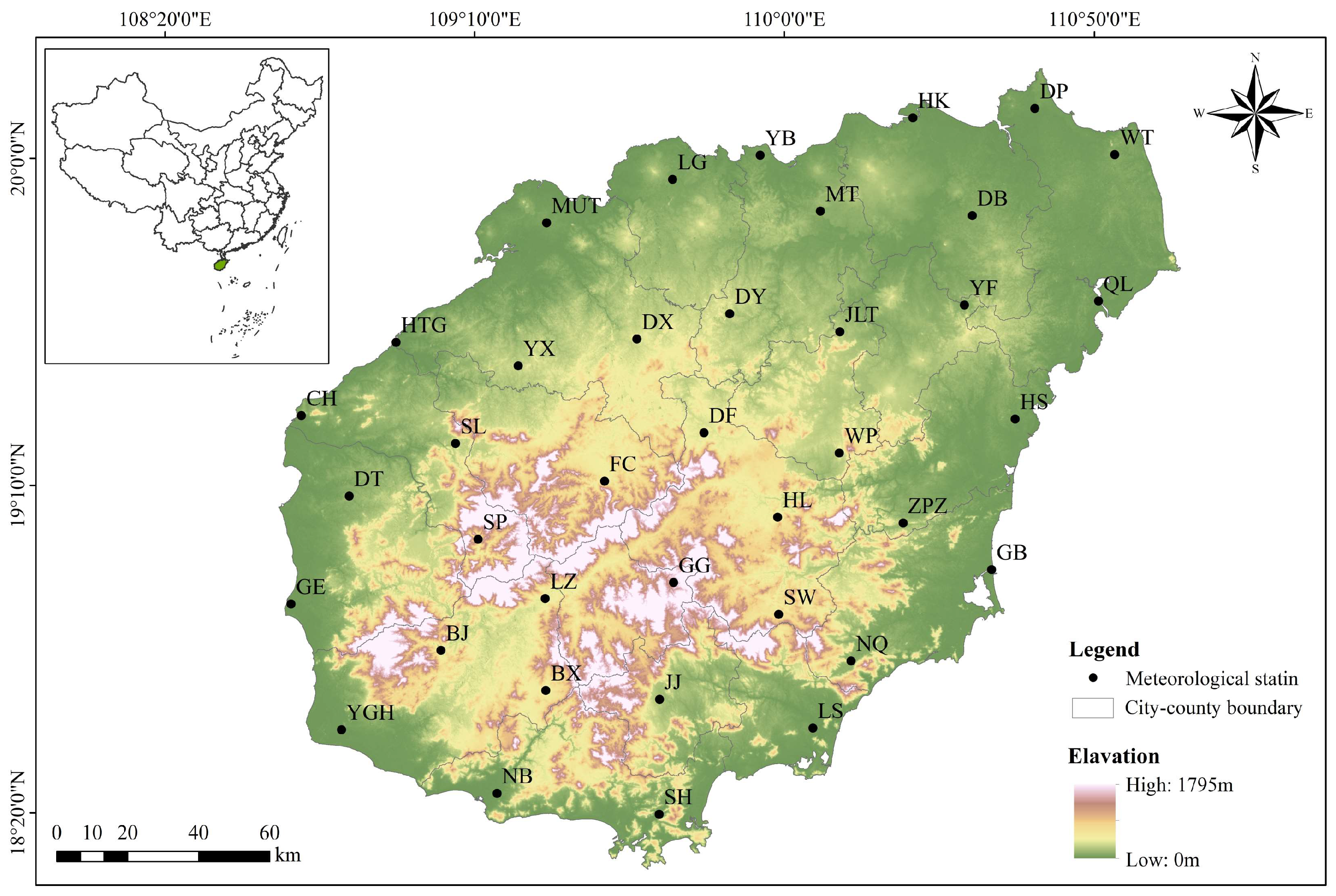
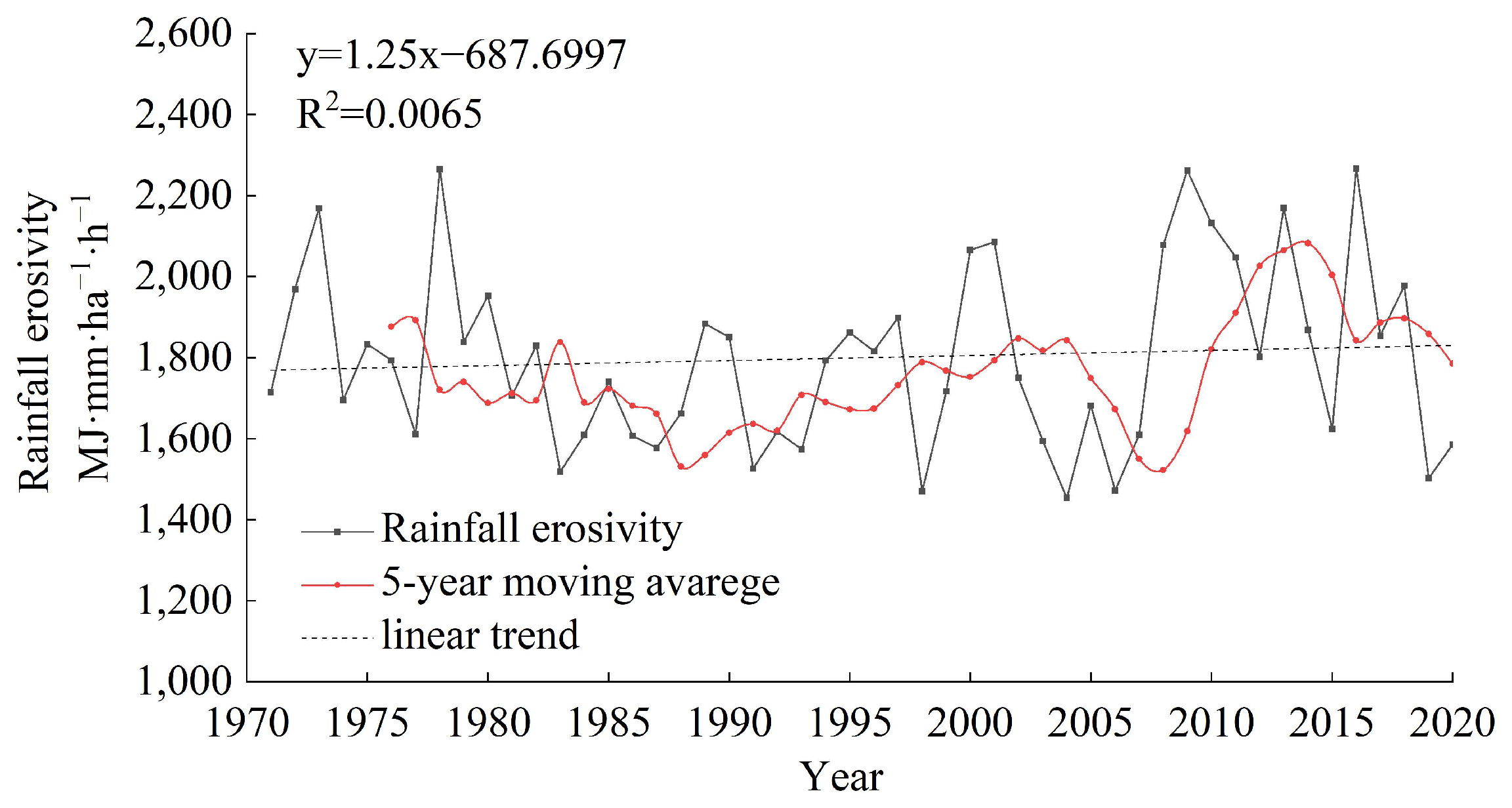
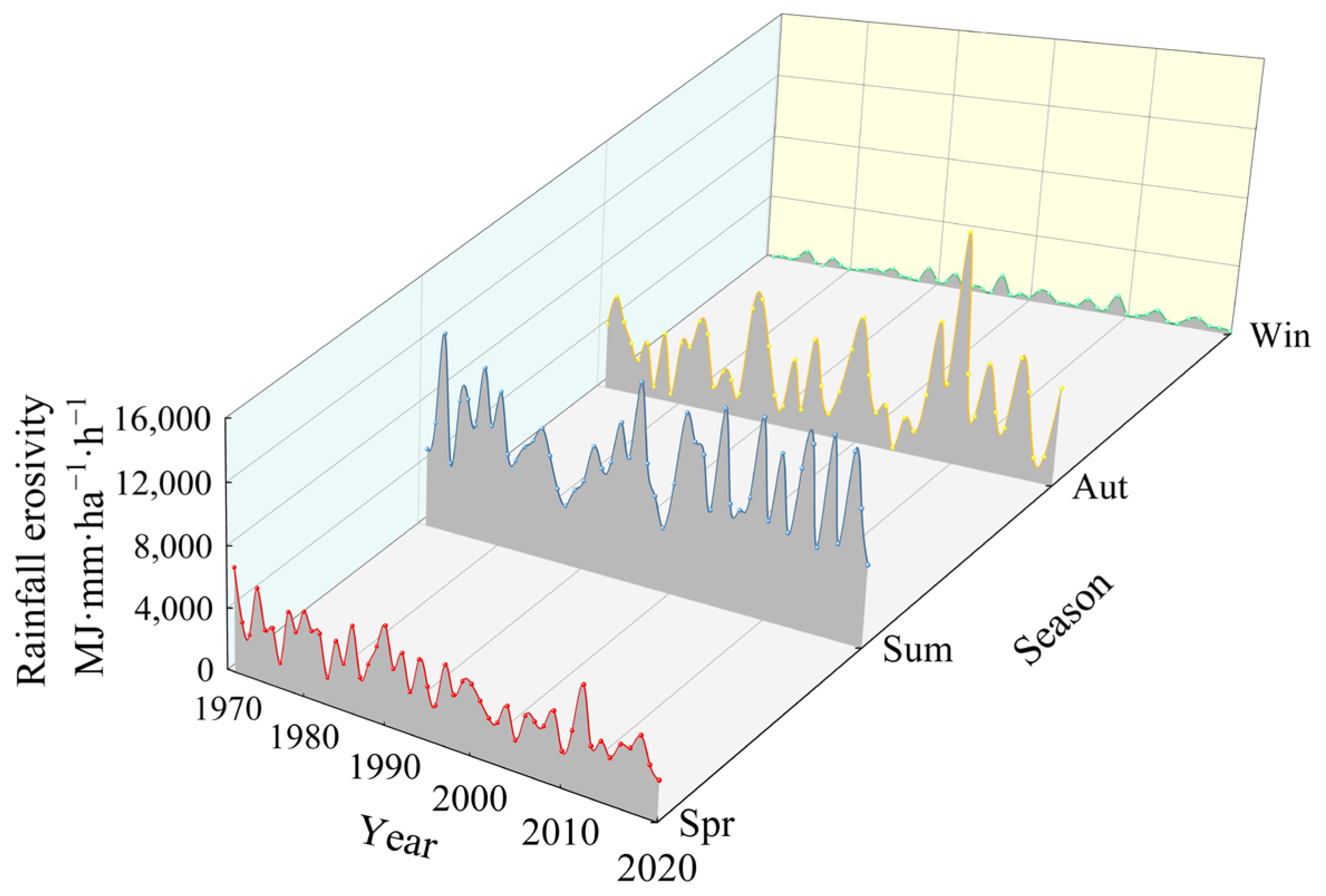


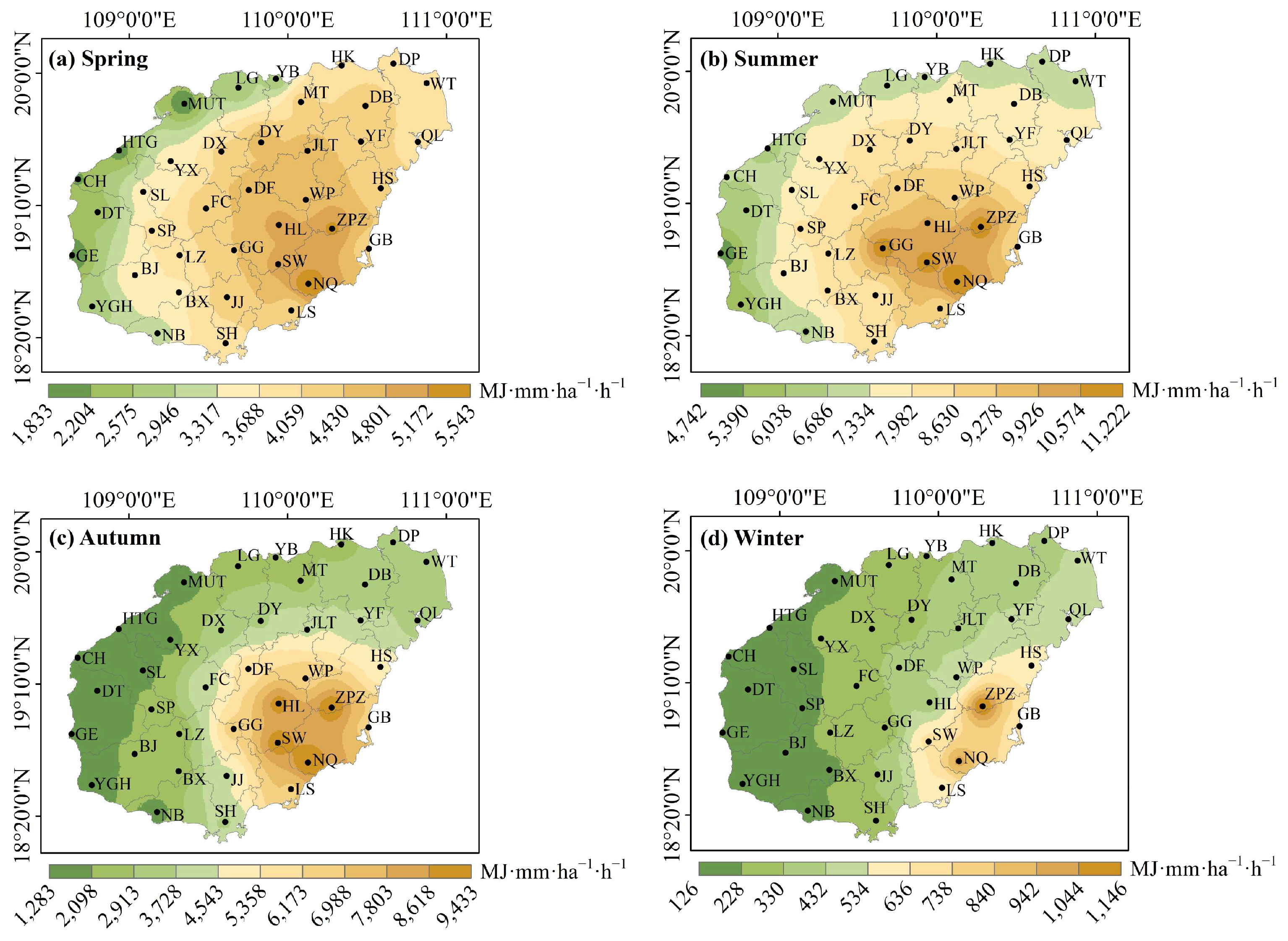
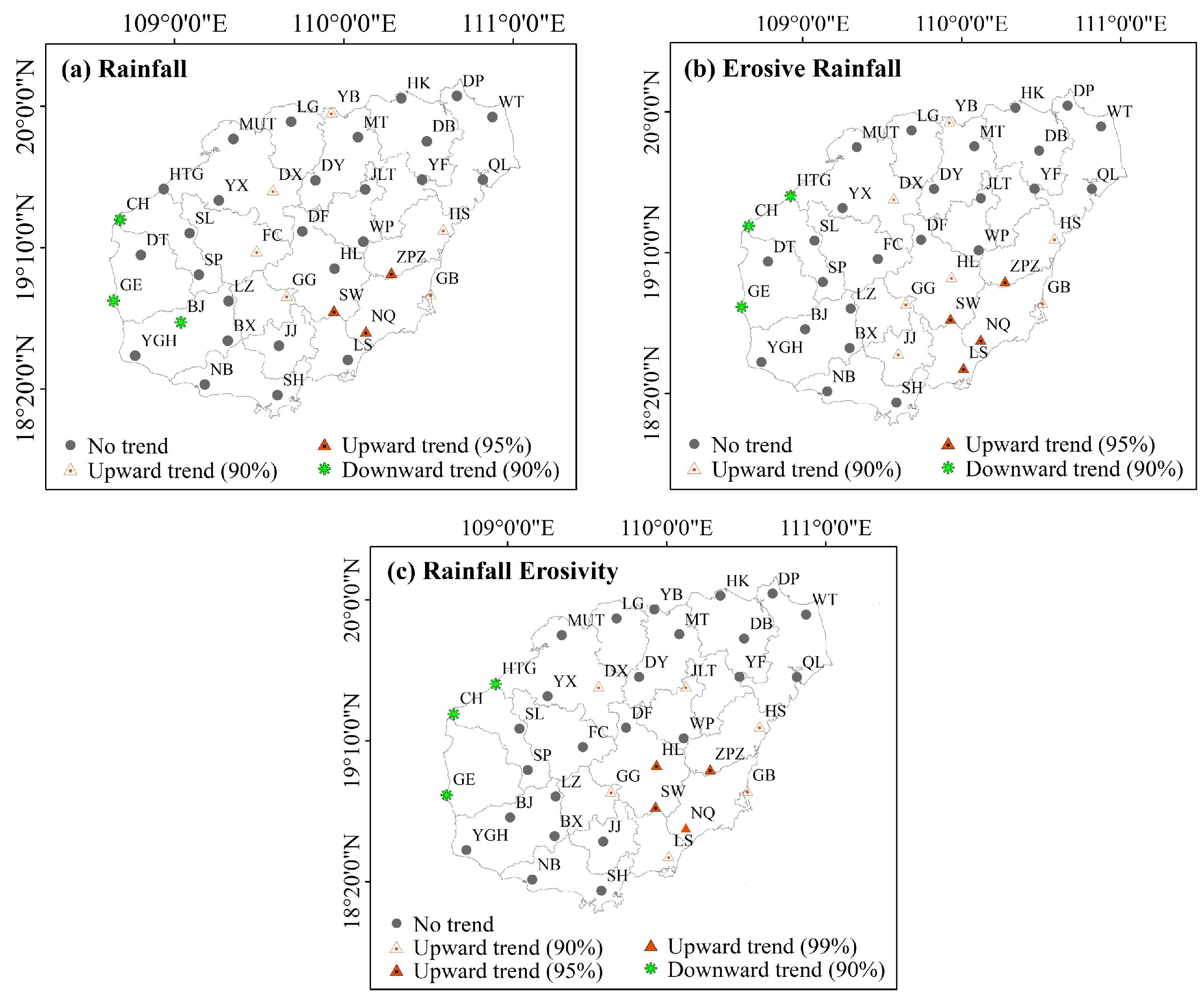
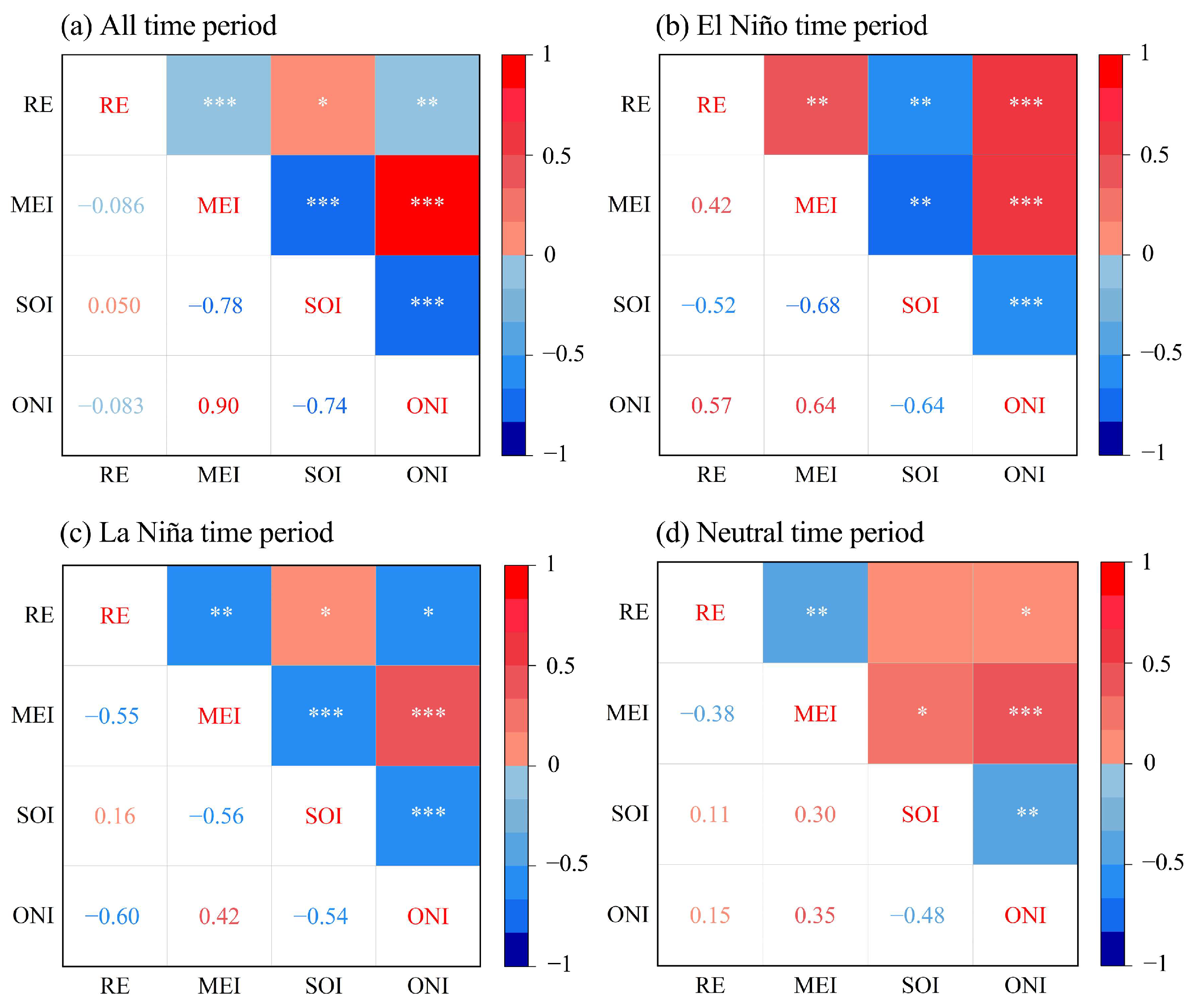

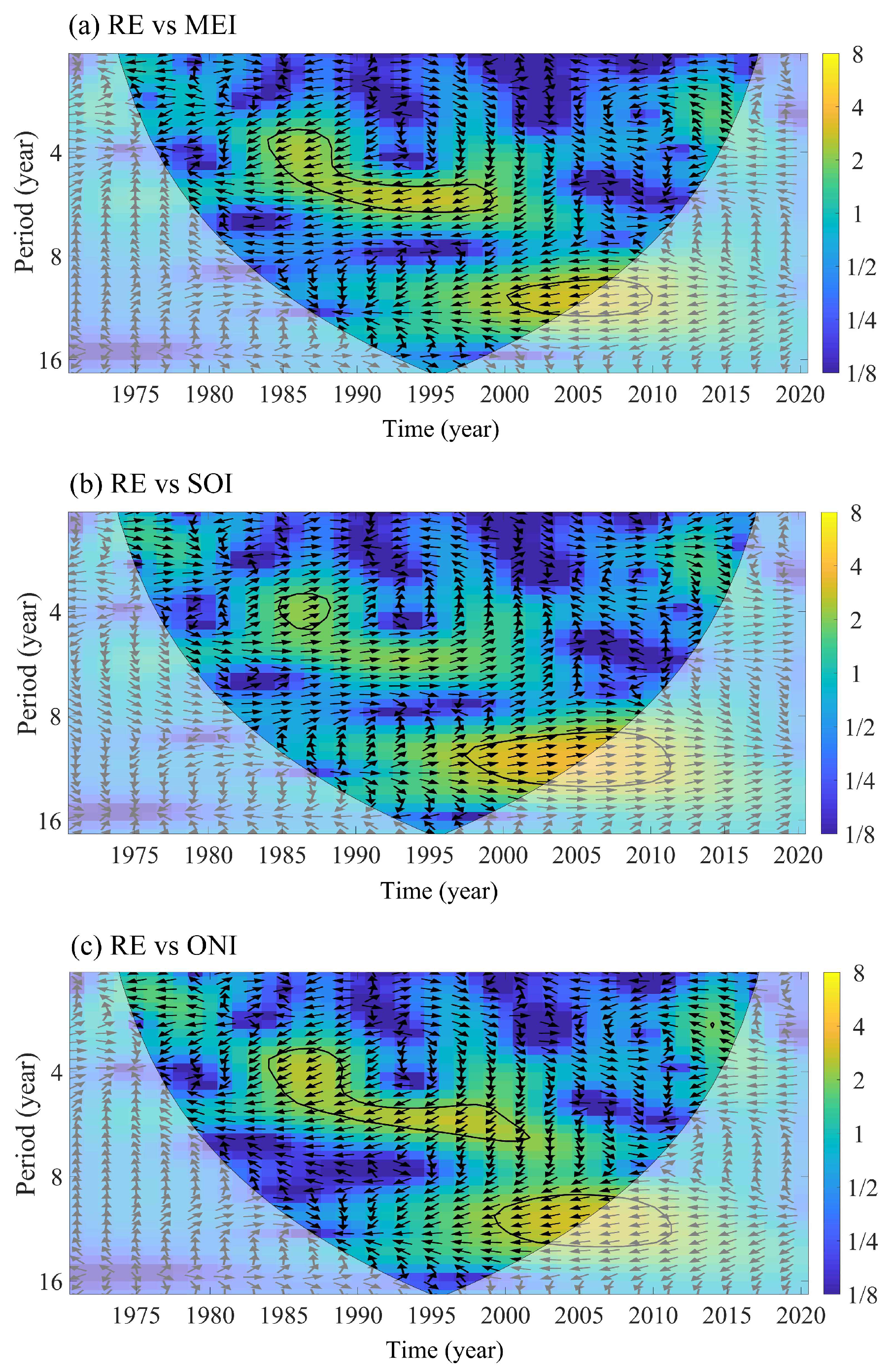
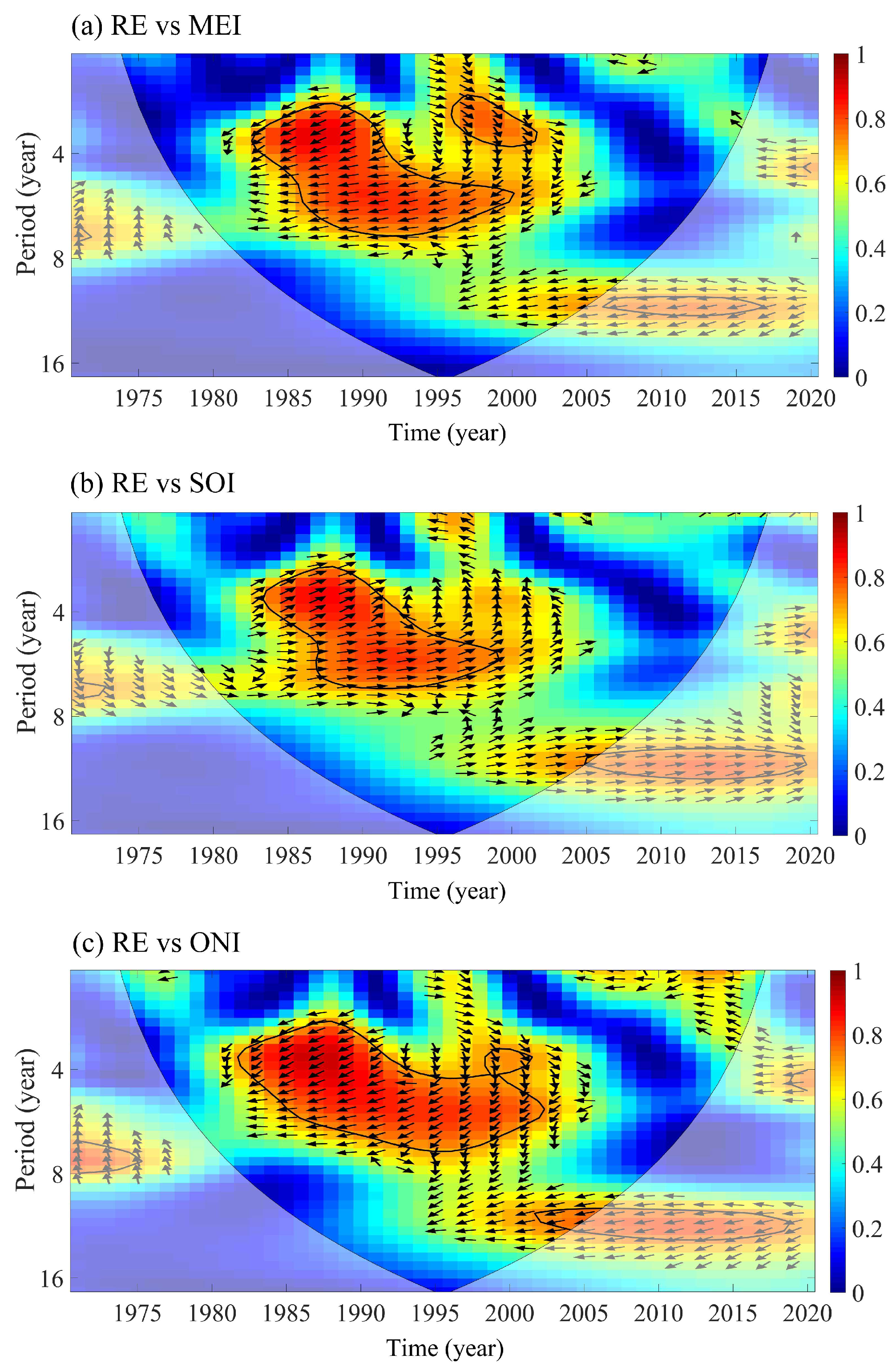

| Parameters | Calculation Models of RE | ||||
|---|---|---|---|---|---|
| Model 1 | Model 2 | Model 3 | Model 4 | Model 5 | |
| Annual average RE (MJ·mm·ha−1·h−1) | 18,021.10 | 17,354.09 | 1580.76 | 12,664.37 | 16,735.37 |
| Standard deviation (mm) | 4498.62 | 4320.15 | 3025.89 | 2731.11 | 3562.90 |
| Coefficient of variation (Cv) | 0.52 | 0.55 | 0.27 | 0.30 | 0.43 |
| Effectiveness coefficient (Ef) | 0.24 | 0.36 | 0.81 | −0.15 | −0.14 |
| Relative deviation coefficient (Er) | 0.26 | 0.41 | 0.08 | 0.60 | 0.35 |
| No. | Station | R with ER | R with RE | ER with RE |
|---|---|---|---|---|
| 1 | Danxian | 0.98 *** | 0.87 *** | 0.91 *** |
| 2 | Mutang | 0.93 *** | 0.80 *** | 0.87 *** |
| 3 | Lingao | 0.98 *** | 0.88 *** | 0.92 *** |
| 4 | Yubao | 0.94 *** | 0.83 *** | 0.90 *** |
| 5 | Fucai | 0.94 *** | 0.84 *** | 0.89 *** |
| 6 | Dafeng | 0.96 *** | 0.85 *** | 0.90 *** |
| 7 | Dunya | 0.97 *** | 0.86 *** | 0.92 *** |
| 8 | Meiting | 0.93 *** | 0.82 *** | 0.85 *** |
| 9 | Jialetan | 0.95 *** | 0.83 *** | 0.89 *** |
| 10 | Yongfeng | 0.92 *** | 0.79 *** | 0.82 *** |
| 11 | Dabao | 0.92 *** | 0.80 *** | 0.84 *** |
| 12 | Haikou | 0.98 *** | 0.86 *** | 0.93 *** |
| 13 | Dongpo | 0.95 *** | 0.87 *** | 0.90 *** |
| 14 | Wengtian | 0.93 *** | 0.84 *** | 0.91 *** |
| 15 | Qinglan | 0.98 *** | 0.88 *** | 0.92 *** |
| 16 | Heshui | 0.93 *** | 0.80 *** | 0.82 *** |
| 17 | Shenwang | 0.95 *** | 0.81 *** | 0.88 *** |
| 18 | Heluo | 0.91 *** | 0.77 *** | 0.80 *** |
| 19 | Wupo | 0.94 *** | 0.83 *** | 0.84 *** |
| 20 | Zhongpingzai | 0.96 *** | 0.85 *** | 0.91 *** |
| 21 | Gangbei | 0.96 *** | 0.82 *** | 0.92 *** |
| 22 | Nanqiao | 0.93 *** | 0.80 *** | 0.85 *** |
| 23 | Lingshui | 0.93 *** | 0.79 *** | 0.83 *** |
| 24 | Jinjiang | 0.97 *** | 0.89 *** | 0.92 *** |
| 25 | Songhe | 0.98 *** | 0.87 *** | 0.92 *** |
| 26 | Nanbing | 0.93 *** | 0.80 *** | 0.83 *** |
| 27 | Yinggehai | 0.96 *** | 0.85 *** | 0.84 *** |
| 28 | Ganen | 0.96 *** | 0.82 *** | 0.83 *** |
| 29 | Datian | 0.94 *** | 0.83 *** | 0.85 *** |
| 30 | Gongguan | 0.93 *** | 0.79 *** | 0.81 *** |
| 31 | Lezhong | 0.96 *** | 0.85 *** | 0.87 *** |
| 32 | Baoxian | 0.93 *** | 0.78 *** | 0.85 *** |
| 33 | Baojie | 0.94 *** | 0.83 *** | 0.82 *** |
| 34 | Sanpai | 0.97 *** | 0.86 *** | 0.93 *** |
| 35 | Shilu | 0.93 *** | 0.81 *** | 0.85 *** |
| 36 | Changhua | 0.92 *** | 0.78 *** | 0.86 *** |
| 37 | Haitougang | 0.95 *** | 0.82 *** | 0.87 *** |
| 38 | Yaxing | 0.96 *** | 0.85 *** | 0.90 *** |
| Mean | - | 0.95 | 0.83 | 0.87 |
| No. | Station | Rainfall (mm) | Erosive Rainfall (mm) | RE (MJ·mm·ha−1·h−1) |
|---|---|---|---|---|
| 1 | Danxian | 4.43 * | 4.86 * | 50.78 * |
| 2 | Mutang | 7.39 | −7.30 | −200.14 |
| 3 | Lingao | 4.77 | 5.06 | 92.39 |
| 4 | Yubao | 11.48 * | 10.00 * | 64.10 |
| 5 | Fucai | 1.73 * | −1.78 | −35.72 |
| 6 | Dafeng | −5.80 | −5.63 | −67.39 |
| 7 | Dunya | 5.09 | 5.57 | 67.25 |
| 8 | Meiting | 2.82 | 3.02 | 49.11 |
| 9 | Jialetan | −0.17 | 0.35 | 7.20 * |
| 10 | Yongfeng | 0.57 | −0.43 | 25.27 |
| 11 | Dabao | 2.62 | 2.01 | 65.34 |
| 12 | Haikou | 0.88 | 1.54 | 46.43 |
| 13 | Dongpo | 4.21 | 3.07 | 16.60 |
| 14 | Wengtian | −5.22 | −5.21 | −47.53 |
| 15 | Qinglan | −3.41 | −3.11 | −53.52 |
| 16 | Heshui | 3.04 * | 2.31 * | 38.50 * |
| 17 | Shenwang | 4.43 ** | 3.16 ** | 31.14 ** |
| 18 | Heluo | −0.46 | 0.42 * | 3.84 ** |
| 19 | Wupo | 5.03 | 4.02 | 55.06 |
| 20 | Zhongpingzai | 0.79 ** | 0.80 ** | −30.94 ** |
| 21 | Gangbei | 5.57 * | 4.16 * | 28.21 * |
| 22 | Nanqiao | 12.79 ** | 13.43 ** | 187.26 *** |
| 23 | Lingshui | 2.56 | 2.89 ** | 24.88 * |
| 24 | Jinjiang | 2.59 | 4.58 * | 58.56 |
| 25 | Songhe | 7.53 | 8.22 | 126.61 |
| 26 | Nanbing | −0.54 | 0.80 | −10.22 |
| 27 | YingGeHai | 2.38 | 2.61 | −4.15 |
| 28 | Ganen | −4.33 * | −4.38 * | −49.46 * |
| 29 | Datian | 7.02 | −7.20 | 100.82 |
| 30 | Gongguan | 0.28 * | 0.55 * | 24.74 * |
| 31 | Lezhong | 4.47 | 4.85 | 30.15 |
| 32 | Baoxian | 6.43 | 5.44 | 43.59 |
| 33 | Baojie | −3.67 * | −3.91 | −32.88 |
| 34 | Sanpai | 2.14 | 2.97 | 46.16 |
| 35 | Shilu | −1.07 | −1.45 | −23.82 |
| 36 | Changhua | −3.24 * | −2.35 * | −63.16 * |
| 37 | Haitougang | −1.00 | −1.08 * | −7.88 * |
| 38 | Yaxing | 0.85 | 1.61 | 29.86 |
| No. | Climate Events | Time Interval | Duration in Months | Average Monthly RE (MJ·mm·ha−1·h−1) |
|---|---|---|---|---|
| 1 | La Niña | 1971.01–1972.01 | 13 | 1238.59 |
| 2 | El Niño | 1972.05–1973.03 | 11 | 1828.15 |
| 3 | La Niña | 1973.05–1974.07 | 15 | 1566.05 |
| 4 | La Niña | 1974.10–1976.03 | 18 | 1025.16 |
| 5 | El Niño | 1976.09–1977.02 | 6 | 2033.39 |
| 6 | El Niño | 1977.09–1978.01 | 5 | 970.70 |
| 7 | El Niño | 1982.05–1983.06 | 14 | 1173.38 |
| 8 | La Niña | 1984.10–1985.06 | 9 | 580.76 |
| 9 | El Niño | 1986.09–1988.02 | 18 | 820.94 |
| 10 | La Niña | 1988.05–1989.05 | 13 | 1126.87 |
| 11 | El Niño | 1991.06–1992.06 | 13 | 1384.28 |
| 12 | El Niño | 1994.09–1995.03 | 7 | 941.24 |
| 13 | La Niña | 1995.08–1996.03 | 8 | 1528.90 |
| 14 | El Niño | 1997.05–1998.04 | 12 | 1095.89 |
| 15 | La Niña | 1998.07–2001.02 | 32 | 1310.41 |
| 16 | El Niño | 2002.06–2003.02 | 9 | 1432.35 |
| 17 | El Niño | 2004.08–2005.02 | 7 | 2334.50 |
| 18 | La Niña | 2005.11–2006.03 | 5 | 298.74 |
| 19 | El Niño | 2006.09–2007.01 | 5 | 1305.12 |
| 20 | La Niña | 2007.07–2008.06 | 12 | 1126.46 |
| 21 | La Niña | 2008.11–2009.03 | 5 | 490.14 |
| 22 | El Niño | 2009.08–2010.03 | 8 | 1849.70 |
| 23 | La Niña | 2010.06–2011.05 | 12 | 1489.59 |
| 24 | La Niña | 2011.08–2012.03 | 8 | 1666.49 |
| 25 | El Niño | 2015.03–2016.04 | 14 | 1038.44 |
| 26 | La Niña | 2016.08–2016.12 | 5 | 1469.98 |
| 27 | La Niña | 2017.10–2018.04 | 7 | 939.39 |
| 28 | El Niño | 2018.10–2019.05 | 8 | 1298.30 |
| 29 | La Niña | 2020.08–2020.12 | 5 | 1922.96 |
| Mean RE in El Niño | 1393.31 | |||
| Mean RE in La Niña | 1185.37 | |||
| Mean RE in ENSO | 1285.75 | |||
| Mean RE in Neutral period | 1349.67 | |||
| Mean RE during the period 1971–2020 | 1306.02 | |||
| Analytical Method | Characteristic Indices of ENSO | AWC | PASC (%) |
|---|---|---|---|
| WTC | MEI | 0.85 | 18.6 |
| SOI | 0.79 | 5.9 | |
| ONI | 0.83 | 9.1 | |
| MWC | MEI-SOI | 0.94 | 3.6 |
| MEI-ONI | 0.95 | 19.0 | |
| SOI-ONI | 0.92 | 5.7 | |
| MEI-SOI-ONI | 0.97 | 4.9 |
Disclaimer/Publisher’s Note: The statements, opinions and data contained in all publications are solely those of the individual author(s) and contributor(s) and not of MDPI and/or the editor(s). MDPI and/or the editor(s) disclaim responsibility for any injury to people or property resulting from any ideas, methods, instructions or products referred to in the content. |
© 2024 by the authors. Licensee MDPI, Basel, Switzerland. This article is an open access article distributed under the terms and conditions of the Creative Commons Attribution (CC BY) license (https://creativecommons.org/licenses/by/4.0/).
Share and Cite
Lu, X.; Chen, J.; Guo, J.; Qi, S.; Liao, R.; Lai, J.; Wang, M.; Zhang, P. Temporal and Spatial Variations in Rainfall Erosivity on Hainan Island and the Influence of the El Niño/Southern Oscillation. Land 2024, 13, 1210. https://doi.org/10.3390/land13081210
Lu X, Chen J, Guo J, Qi S, Liao R, Lai J, Wang M, Zhang P. Temporal and Spatial Variations in Rainfall Erosivity on Hainan Island and the Influence of the El Niño/Southern Oscillation. Land. 2024; 13(8):1210. https://doi.org/10.3390/land13081210
Chicago/Turabian StyleLu, Xudong, Jiadong Chen, Jianchao Guo, Shi Qi, Ruien Liao, Jinlin Lai, Maoyuan Wang, and Peng Zhang. 2024. "Temporal and Spatial Variations in Rainfall Erosivity on Hainan Island and the Influence of the El Niño/Southern Oscillation" Land 13, no. 8: 1210. https://doi.org/10.3390/land13081210





